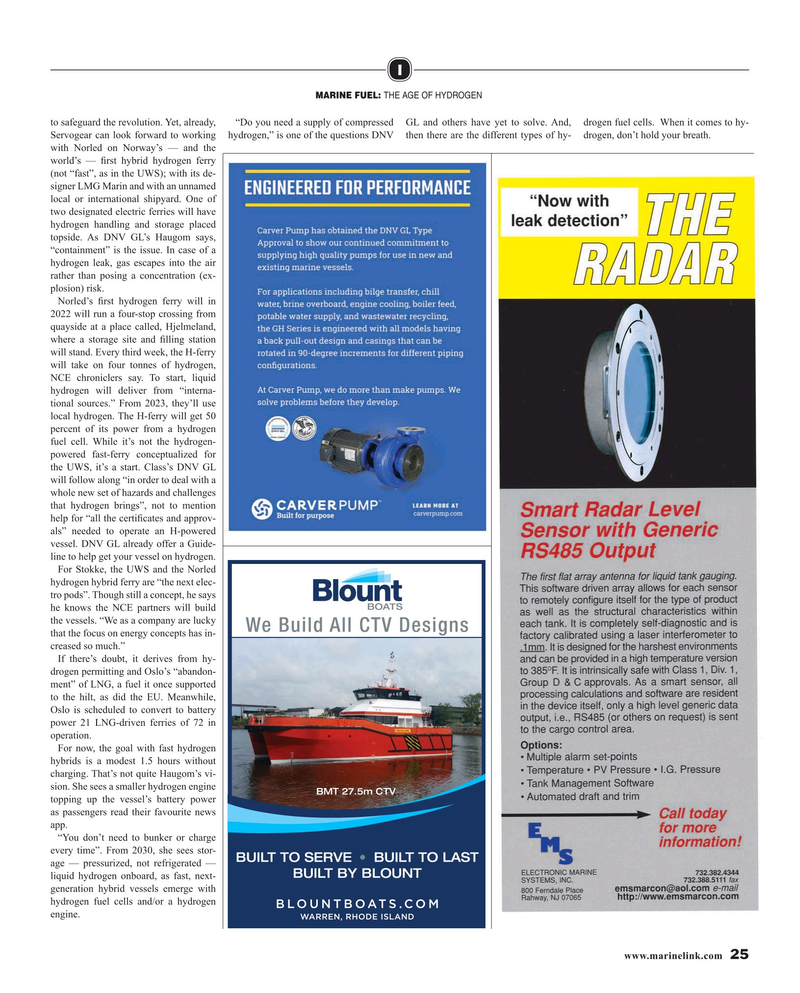
Page 25: of Maritime Reporter Magazine (August 2019)
The Shipyard Edition
Read this page in Pdf, Flash or Html5 edition of August 2019 Maritime Reporter Magazine
I
MARINE FUEL: THE AGE OF HYDROGEN to safeguard the revolution. Yet, already, “Do you need a supply of compressed GL and others have yet to solve. And, drogen fuel cells. When it comes to hy-
Servogear can look forward to working hydrogen,” is one of the questions DNV then there are the different types of hy- drogen, don’t hold your breath.
with Norled on Norway’s — and the world’s — ? rst hybrid hydrogen ferry (not “fast”, as in the UWS); with its de- signer LMG Marin and with an unnamed local or international shipyard. One of two designated electric ferries will have hydrogen handling and storage placed topside. As DNV GL’s Haugom says, “containment” is the issue. In case of a hydrogen leak, gas escapes into the air rather than posing a concentration (ex- plosion) risk.
Norled’s ? rst hydrogen ferry will in 2022 will run a four-stop crossing from quayside at a place called, Hjelmeland, where a storage site and ? lling station will stand. Every third week, the H-ferry will take on four tonnes of hydrogen,
NCE chroniclers say. To start, liquid hydrogen will deliver from “interna- tional sources.” From 2023, they’ll use local hydrogen. The H-ferry will get 50 percent of its power from a hydrogen fuel cell. While it’s not the hydrogen- powered fast-ferry conceptualized for the UWS, it’s a start. Class’s DNV GL will follow along “in order to deal with a whole new set of hazards and challenges that hydrogen brings”, not to mention help for “all the certi? cates and approv- als” needed to operate an H-powered vessel. DNV GL already offer a Guide- line to help get your vessel on hydrogen.
For Stokke, the UWS and the Norled hydrogen hybrid ferry are “the next elec- tro pods”. Though still a concept, he says he knows the NCE partners will build the vessels. “We as a company are lucky
We Build All CTV Designs that the focus on energy concepts has in- creased so much.”
If there’s doubt, it derives from hy- drogen permitting and Oslo’s “abandon- ment” of LNG, a fuel it once supported to the hilt, as did the EU. Meanwhile,
Oslo is scheduled to convert to battery power 21 LNG-driven ferries of 72 in operation.
For now, the goal with fast hydrogen hybrids is a modest 1.5 hours without charging. That’s not quite Haugom’s vi- sion. She sees a smaller hydrogen engine
BMT 27.5m CTV topping up the vessel’s battery power as passengers read their favourite news app. “You don’t need to bunker or charge every time”. From 2030, she sees stor-
BUILT TO SERVE BUILT TO LAST age — pressurized, not refrigerated —
BUILT BY BLOUNT liquid hydrogen onboard, as fast, next- generation hybrid vessels emerge with hydrogen fuel cells and/or a hydrogen
BLOUNTBOATS.COM engine.
WARREN, RHODE ISLAND www.marinelink.com 25
MR #8 (18-25).indd 25 8/1/2019 11:25:43 AM

 24
24

 26
26
